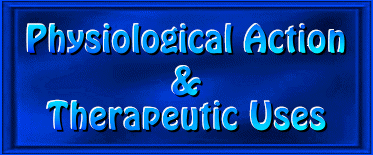

The following is excerpted from The Professional's Herbal Formula Handbook No. 7, comprising 52 pages of traditional information and recent scientific data that describes the medical properties, physiological action and therapeutic uses for each of the 24 ingredients outlined in this formula.




Adaptogenic, alterative, anabolic, anti-cachexic, anti-depressant, anti-dyscratic, aphrodisiac, eutrophic, relaxant, rejuvenative, restorative, mild sedative, stimulant (circulatory and secretolytic), thymoleptic, tonic and vasodilator.


Alleviates any general fluids dyscrasia
(abnormal or pathological condition) within the blood vessels or
tissue-systems throughout the reproductive organs that leads to
the onset of various degenerative or debilitative conditions
associated with a lack of sexual arousal or desire, and
eliminates any form of cachexia (general debility) and chronic
fatigue or exhaustion throughout the sexual organs in order to
improve one's overall sexual potency and power; reduces any
excessive seminal emissions or premature ejaculation associated
with spermatorrhea (involuntary discharge of semen), and eases
any anxiety neurosis or nervous depression associated with sexual
dysfunction or inadequacy; acts as a mood-elevating agent in
order to relieve various forms of anxiety, depression or related
depressive states, and demonstrates thymoleptic (mood-elevating)
properties in order to enhance the overall mood parameters within
the personality structure; displays significant effectiveness in
the removal of any functional impotence associated with arterial
erectile dysfunction, and directly contributes to the anabolic,
eutrophic and metabolic health and vitality of all the cellular
processes and tissue-systems; exhibits aphrodisiac properties in
order to generate greater sexual arousal and desire, as well as
increased sexual potency and power; demonstrates vasodilator
activity in order to dilate the blood vessels of the skin and
mucous membranes, thereby transporting the blood closer to the
surface of the sexual organs; displays direct effects upon
endothelial cells, which enhance blood flow to both the penile
arteries and veins without any alteration in systemic blood
pressure; re-establishes effective tissue perfusion, and
increases the perfusion rate to various areas of the vascular
system (e.g., arterial, arteriolar, microcirculatory, venular and
venous components); enhances greater cellular energy production
by beneficially affecting the various intracellular components,
and displays vasodilator activity by directly stimulating the
release of endogenous or endothelium-derived relaxing factor
(EDRF) in the arterial endothelium (such as prostacyclin);
stimulates the synthesis of prostacyclin, which is the natural
anti-aggretory prostaglandin that is synthesized by the vascular
endothelium (the cells that line the inside of the blood vessel);
stimulates the release of certain chemical neurotransmitters
known as catecholamines (epinephrine and norepinephrine), thereby
enhancing the functional capabilities of the entire network of
catecholaminergic glandular, nervous and cardiovascular systems;
displays stimulating activity upon the central adrenergic system,
and re-activates the noradrenergic system of the cerebral cortex;
increases the number of cholinergic receptor sites in the brain
in order to revitalize any decreasingly ineffective cerebral
tissue, and improves the synthesis and turnover rate of the
various cerebral neurotransmitters; stimulates greater
neurotransmitter release into the synapses, and increases the
rate in which information is transmitted at the nerve cell level;
inhibits any enzymatic breakdown of the neurotransmitters, and
improves the neurotransmitter signals while preserving the
functional capabilities of neurotransmitters; exhibits powerful
adaptogenic (balancing and strengthening) activity in order to
increase the overall resistance of an organism towards any
adverse influences or stressful conditions (whether they be
physical, chemical or biological in nature), especially upon the
endocrine glandular system, blood vessels, musculature, immune
system, and both the central (cerebro-spinal centers) and
peripheral nervous systems; displays adaptogenic and anabolic
activity in order to provide greater strength and vitality
throughout the blood vessels, tissue-systems and musculature; and
demonstrates regulatory activity in order to normalize any
overactive or underactive glandular functions; exhibits
circulatory stimulant activity in order to permeate the entire
organism (both internally and externally) with greater warmth and
movement, thereby supporting the innate warmth that resides in
the blood and muscle tissues; acts as a secretolytic stimulant in
order to promote increased gastric, pancreatic or intestinal
secretory and motor activity, and enhances greater peripheral
circulation (due to its antioxidant activity); exhibits
significant antioxidant effects in order to provide greater
oxygen-transport capabilities throughout the bloodstream, as well
as enhance the transport of additional oxygen directly into the
cells and tissue-systems throughout the blood vessels and
musculature; acts as a circulatory stimulant by increasing the
blood flows through the arteries and blood vessels of the muscles
in order to enhance greater nutrient transport, absorption and
utilization, thereby accelerating the healing processes
associated with the repair of any damaged blood vessels or
tissue-systems throughout the reproductive system; demonstrates
significant rejuvenative and restorative properties upon the
basic plasma tissue-systems throughout the entire organism,
thereby enhancing the production of vital bodily fluids while
providing greater enrichment through increased assimilation of
the various organic mineral salts; accelerates the recuperative
processes that are essential in order to overcome any chronic
degenerative or debilitative illnesses, while facilitating
greater recovery response in order to fully regain optimal health
and well-being; displays alterative activity in order to correct
any disordered bodily function, thereby activating increased
alterations in both metabolic and tissue functions as a defensive
measure against the onset of acute or chronic disease; exhibits
restorative effects in order to regain increased vigor or
vitality and greater strength, while enhancing normal tissue and
metabolic functional capabilities; demonstrates alterative and
restorative properties in order to re-establish healthy systemic
functional capabilities, as well as to establish greater vascular
tone throughout the entire organism (due to its ability to
stimulate increased secretory flows); exhibits alterative effects
in order to stimulate the anabolic growth processes, thereby
enhancing the repair of any degenerated, deteriorated and
debilitated cells or tissues (while promoting the elimination of
any catabolic waste materials); displays tonifying effects in
order to permanently enhance the overall energy-levels throughout
the entire organism, without adversely affecting the functional
capabilities of any particular organ or system.
![]()
None.
![]()